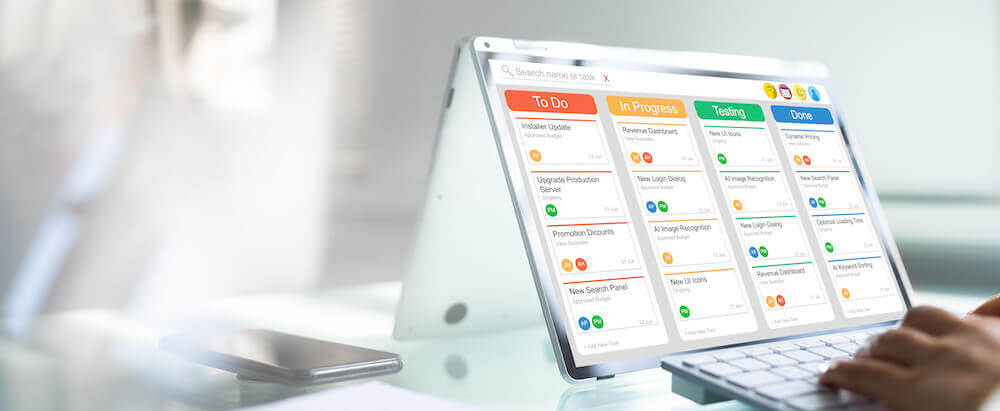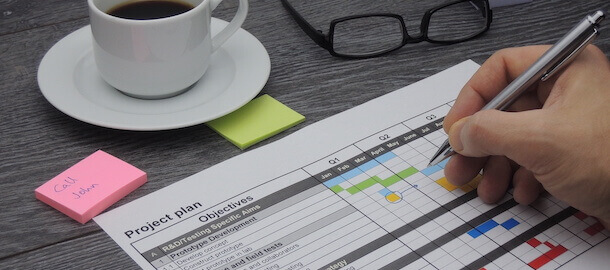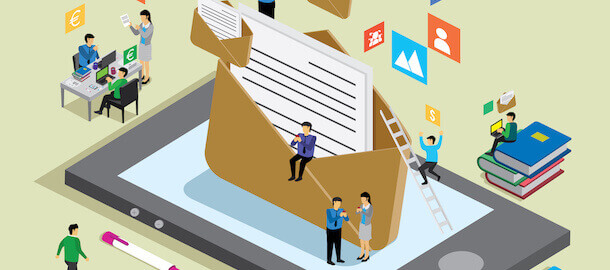
Every successful project starts with a plan. But planning for a big project can be almost as much work as the project itself.
The planning process in project management is easiest when you follow a guide. It helps take the stress out of what can be a complicated process and ensures you cover all the details for a successful project.
Today, we’ll take you from the first step in project planning all the way through to the finishing project planning stages.
Here’s how to create a project plan for your project, start to finish, in a step-by-step guide.
What Is Project Planning?
Project planning is a key first step in any project management process. Without a plan, you’re likely to get off track, waste time and overlook something important.
A project plan is the roadmap for a successful project and the project planning process is what you use to create it.
When planning a project, you consider:
- The people on all sides who will be involved in the project.
- The goals, objectives and outcomes you hope the project will achieve.
- And all the work that will be required to make the project happen.
Project planning is also the stage in project management where you will consider contingencies — your Plan B for when things don’t go to plan — and how you will handle and recover from any setbacks.
Other project planning elements also come into play, such as project scope, where you decide what is and isn’t relevant for the project and hand, and your plan for project communication, which is key for a successful project.
Why Is Project Planning Important?

In project management, the project planning process is especially important because it sets you up for success with your project.
It is designed to make things easier for the project manager, break things down into smaller more manageable steps and allow you to plan ahead for time and resource needs.
Project planning is important because it answers a number of key questions about a project, such as:
- What tasks need to be done, when, and how?
- Who is responsible for each of the tasks?
- How communicate will happen during this project?
- What the plan is for handling issues that come up?
- How project progress will be tracked and monitored?
Project planning is important, but it’s not the only part of managing a project. It also fits into a larger project management process.
How Project Planning Fits Into Project Management
When you start managing projects, you’ll find that project planning is not the only important aspect of project management. There are other things that go into it.
According to the experts at the Project Management Institute (PMI), there are actually five phases of project management and project planning is just one of them.
However, project planning is still pretty important. Planning well for your project is so crucial that you may spend as much as half of the project in the planning stage.
But since it’s often helpful to look at the big picture, it’s good idea to take a look at all five phases of the project management process.
What Are the 5 Phases of Project Management?

The experts at PMI have spent decades studying and perfecting what goes into effectively managing a project. For any project, PMI says there are five phases you must progress through:
- Initiation
- Planning
- Execution
- Monitoring and Control
- Closure
Each one is important for moving through the project and arriving at a successful result. Consider how each one of these phases impacts a typical project:
1. Initiation
Everything has a beginning and the initiation phase is it for project management. This first step is about realizing the desire or need for the project and the possibility of taking it on.
In the initiation phase, you may:
- Evaluate the project idea.
- Consider project fit and feasibility.
- Think about outcomes and benefits.
- Draft project charter documentation.
- Propose budgets, goals, constraints.
- Make a list of potential stakeholders.
As someone interested in understanding the project planning process, you will realize right away that a lot of early project planning takes place during the initiation phase.
However, the initiation phase is still a point where things are intentionally left a bit vague. Once you’re ready to start filling in the details and making some concrete decisions about the project, it’s time to move on to the project planning phase.
2. Planning
The planning phase is the second phase of the project management life cycle and the first phase where you will undertake significant detailed work on the project.
The planning phase is primarily about creating a roadmap that will guide you through the rest of the project.
Important elements of the planning phase will include decisions on:
- Stakeholders
- Goals
- Resources
- Tasks
- Deliverables
- Schedules
- Risks
- Feedback
- Communications
Obviously, there’s a lot to project planning, but primarily you’ll focus on:
- Setting goals and objectives.
- Working out budgets and costs.
- Defining scope and deliverables.
It’s best to start vague and then fill in the details:
- Are your goals and objectives S.M.A.R.T. (specific, measurable, attainable, realistic and timely) or C.L.E.A.R. (collaborative, limited, emotional, appreciable and refinable)?
- Do you have a plan for how you will procure, utilize and manage resources and work within your budget by minimizing costs?
- Have you set out a clear timeline of what needs to happen and when, with key milestones for deliverables with their due dates?
Scope creep, cost overruns, delays and other project risks are a real possibility, so your planning also needs to take these factors into account.
It’s a lot to think about, which is why this phase of project management can consume a lot of time and attention. But once you’ve got a detailed project plan, you’ll transition to the next phase of project management: execution.
3. Execution
The third phase of project management is where ideas come off the page and you and your team begin the real work of the project.
Project execution is about following the plan you’ve designed in the previous stages.
- Task work begins.
- Collaboration starts.
- Progress is made.
- Deliverables are created.
As a project manager, your role during the execution phase is to make sure everyone knows what they have to do, people have what they need to get started, and everything progresses smoothly.
Once things are underway, your team may continue on in the execution phase, but you’ll transition to the next phase: project monitoring and control.
4. Monitoring and Control
One of a project manager’s main responsibilities in any project is monitoring and control. This phase often overlaps partially or fully with the execution phase.
A project manager has various ways of helping make sure sure the project stays on track, such as monitoring:
- Critical success factors (CSFs), which are the key areas of the project that are determined to be vital to its success, such as leadership, teamwork, communication and costs.
- Key performance indicators (KPIs), which are specific metrics you choose during the planning of the project that show how efficiently you are meeting your goals and objectives.
During the monitoring and control phase, you’ll not only observe whether the project is running smoothly, you’ll also take action to try to improve processes and solve problems if and when they do occur.
Most importantly, you’ll pay attention to budgets, deadlines and progress so that you can reach the successful completion of the project and the last phase of project management.
5. Closure
The fifth phase of project management is closure. This phase is often shorter than any of the others, but it’s still important.
With the closure of the project, the project manager is responsible for making sure the finished deliverable is formally handed over to the necessary parties.
There may be things to explain and questions to answer for clients and paperwork to sign for those who participated in the project.
The last phase of a project also often involves a team meeting or a report, where the project is evaluated in terms of what went well and where there are areas for improvement to work on for the next project.
If you’ve worked out a thorough project plan and carefully monitored and managed your project, the closure phase should be a time to celebrate a job well done.
How to Create a Simple Project Plan Online or On Your Computer

Once you break it down into steps, the project management process isn’t as hard as it seems. You can break process down even further to easily create a project plan online or on your computer for your next project.
Here’s a simple project planning guide that breaks this process down into nine project planning stages:
1. Identify the Stakeholders
The first step in project planning is to identify the stakeholders of your project. A stakeholder is a person or group who has an interest in the project outcome and can either affect or be affected by the project.
Project stakeholders typically include people inside your organization who will work on the project and be responsible for its outcome, such as your:
- Company
- Leadership
- Team members
However, your list of stakeholders should also include those outside your organization who will be impacted by your project, such as your:
- Clients
- Customers
- End-users
- Community
You could also have stakeholders that will actively participate in the project who are outside of your organization, such as specialists, contractors or vendors.
When you’ve identified all of your project stakeholders, you can congratulate yourself for being done with the first step in project planning and focus on moving on to the next stage of planning: roles and responsibilities.
2. Define Roles and Responsibilities
Once you have a list of all your project stakeholders, it’s time to define their roles and responsibilities.
Deciding how stakeholders will be contributing comes early in project planning because many later steps depend on getting this element just right.
When thinking about project roles, remember these guidelines:
- A role is not necessarily the same thing as a person.
- A person can often play more than one role in a project.
- A role can be shared by multiple people divvying up the work.
Problems cans result if people or roles are mismatched or if a key role is left unfilled. Consider the skills required and competencies available to match your people to the right roles and cover key responsibilities.
3. Hold the Kickoff Meeting
The first meeting you have with all the project stakeholders is called the “kickoff” meeting and it’s the next step in the project planning process.
However the kickoff meeting isn’t just a get-together. There are goals to hit and an agenda to cover.
The primary goals of the kickoff meeting are to:
- Bring all the stakeholders together.
- Share your vision for a successful project.
- Meet and establish good working relationships.
To accomplish these goals, it’s important to go into the meeting with a clear agenda.
- Let everyone get acquainted.
- Go over the project’s background.
- Discuss the purpose of the project.
- Touch on scope, methods and processes.
- Cover the roles for all the stakeholders.
- Open the floor for questions.
- Wrap things up.
A good kickoff meeting should be informative but not too detailed yet. Make sure it’s collaborative, so you can benefit from the expertise and perspectives of other stakeholders during the rest of the planning and execution of the project. Send out meeting minutes and leave open a line of communication if attendees still have questions.
4. Define Project Scope, Budget and Timeline
After the kickoff meeting, you should be ready to dive into the more details of the project, specifically, it’s scope, budget and timeline.
- For the project scope, it’s important not only to define what will be part of the project but also what will not be part of it. Scope is about limiting the project to achievable and realistic objectives.
- For the project budget, you’ll determine what resources are needed and available to meet the specific objectives of the project and what the total cost of the project will be.
- For the project timeline, you’ll think about what phases of the project it will be necessary to go through and start making some estimates about how long each of these phases can be expected to last.
A project’s scope, budget and timeline are major project planning elements that you are likely to spend a lot of time working on. Don’t be afraid to give this stage of the planning process the time it takes to get it right. It will increase the likelihood of your success.
5. Set Goals and Prioritize Tasks
The next stage of the project planning process is about setting goals and prioritizing key tasks.
This next step focuses on determining all the in-between tasks and goals that will help you get there.
- Start by breaking down the project into distinct phases.
- Define individual goals you need to achieve for each phase.
- Make sure your goals are S.M.A.R.T. and/or C.L.E.A.R.
- Work out the tasks needed to reach each goal.
- Prioritize tasks in order of importance for the project.
- Consider the dependencies that exist between the tasks.
- Have contingencies to adjust if/when goals aren’t met on time.
At this point, you should have a good understanding of the purpose of the project, a vision for what success will look like and the steps needed to make it all happen.
6. Define the Project Deliverables
The next project planning stage involves defining your project deliverables.
A deliverable is something that is able to be delivered, but the term has a more specific meaning for the planning process in project management.
The Project Management Institute defines a deliverable as a unique and verifiable product, result or capability to perform a service that is produced in order to complete a project, project phase or process.
This means that a wide range of deliverables are possible, but it all depends on your project.
- For an auto manufacturer project, a deliverable might be a new car rolling off the assembly line.
- For an advertising firm marketing project, a deliverable might be a new ad appearing on a billboard.
- For a customer service center project, a deliverable might be the capability to receive a customer call.
The deliverables you define for your project should be tied to the project’s central objectives. A project can have one final deliverable, or several that are produced in different phases of the project. A deliverable may be something tangible, but it doesn’t have to be.
7. Create the Project Schedule
As you near the end of your project planning process, it’s time to create a detailed project schedule.
The project schedule is a document that needs to include a few important things:
- A detailed timeline for the whole project.
- A description of the resources allotted for each task.
- Any instructions or info needed to complete the tasks.
A good project schedule can be tricky to create, because it has to strike a balance between being detailed and being easily understandable.
However, the process of creating the schedule is much like the earlier stages. You’ll continue to break things down into smaller and smaller steps, then look at how these pieces need to fit together.
Things to keep in mind include:
- What activities make up tasks and project phases.
- What items are dependent on other items in the schedule.
- What sequence of activities is the most logical and efficient.
- What resources and time each task is estimated to consume.
As you work through the project schedule stage, don’t be afraid to revisit previous stages and make adjustments. If something will require additional resources or a few additional days of work to make the project successful, it’s better to plan for it now, rather than be caught off guard later.
8. Complete a Risk Assessment
After scheduling, the next step when you’re planning a project is to complete a risk assessment. A risk assessment lets you take a realistic look at what might go wrong during your project and work out some proactive steps to minimize any damage.
A risk assessment is another good time for collaboration with the other stakeholders. While you may have your own insight on what risks exist, other stakeholders can bring a fresh perspective with risks you may not have thought of.
Common project risks include:
- Project delays
- Resource shortages
- Scope creep
- Technological failures
- Communication problems
While almost anything could go wrong during the project, some risks are more likely than others. Like other aspects of the project, prioritizing comes in handy.
Focus on the risks that are most likely and come up with a plan to reduce these risks and handle them quickly if they do occur.
9. Communicate Your Project Plan
By the end of the project planning process, you will have covered a lot of ground. At this point, your plan should be in great shape. There’s just one thing left to do: communicate your plan to everyone who will be involved.
A lot depends on how well the stakeholders understand your plan and how closely they follow it. So it’s a must to communicate all the details clearly to everyone that’s involved.
A part of your plan may also involve how you want other stakeholders to communicate with you and each other during the project. This also needs to be communicated at the end of the planning phase so that it can be put into action for the project execution.
Make sure to cover preferred communication channels and expectations for when and how to share updates and ask questions.
How Project Planning Software Can Help with Project Planning

Project planning can be a big undertaking. Large projects can take months or years to plan effectively. Even smaller projects can take weeks to plan.
With so much time and energy going into the planning of your project, it makes sense to use technology to make the planning process easier.
Project planning software can help you avoid the inefficiencies of trying to plan projects on paper, juggling multiple project spreadsheets or doing your project plan online through email threads.
A project planning software tool like Folio can simplify your project planning process and even help you manage your project execution after the planning is done.
Folio is an easy-to-use email add-on for your Gmail or Outlook inbox that helps you stay organized, no matter what type of project you’re planning or managing, with features to:
Organize Stakeholder Contact Info Automatically
Folio uses AI-powered algorithms to connect the dots, automatically organizing the contacts for each of your projects and keeping everyone in the loop when you communicate.
Sort Communications by Project Automatically
Folio has Smart Folders that keep your inbox neat and tidy, even when you’re managing communications with multiple stakeholders and multiple projects.
Keep All Your Documents Organized
Folio’s Smart Folders also help you keep track of important email attachments related to your project, with easy integration with Google Docs for storing project documents in the cloud.
Integrate Your Task Management
Folio adds new functionality to your existing Gmail and Outlook task management features, letting you create, assign and track tasks from your email with just a few clicks.
Handle Task Prioritization Details
Folio has features to help you set task priorities, define milestones and meet project goals, saving you hours of work per week, thanks to our smart AI-powered algorithms.
Stay on Top of Deadlines
Folio connects with your calendar, letting you set task due dates and track multiple project deadlines so that you can stay on track and finish your project on schedule.
Get Notifications and Reminders
Folio features customizable notification and reminder settings that keep you informed about the status of your project, even when your inbox fills up and things get busy.
Share Real-Time Project Updates
Folio comes with real-time project update features, allowing you to create custom timelines that can be shared with customers, clients and other stakeholders to keep everyone in the loop.
The project planning process doesn’t have to be difficult. Understand how project planning fits into project management, follow the right steps to plan your project, and take advantage of project planning software to help plan your next project.
Try Folio today for free with up to three projects and simplify your project planning process.
Who we are
We've built Folio: the first AI email assistant for professionals.
Folio plugs directly into your work email inbox and automatically organizes your email, giving you contextual access to all the information you need to increase your productivity in minutes.
We are a team of passionate product people and engineers that gets excited about solving complex processes and creating value for people.
We're a venture funded company backed by Accel Partners, Vertical Venture Partners, and other leading venture capital firms and angel investors such as Ash Patel and Jerry Yang.


